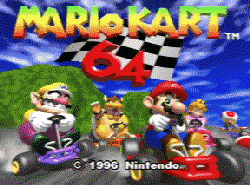
Mario Kart 64 is a good game | |
|
Publisher: Nintendo of America Developer: Nintendo Co. Ltd. Genre: Racing As with so many Shigeru Miyamoto creations, Mario Kart for the Super NES broke gameplaying barriers. While retaining the cartoony universe of Mario and friends, the game explored an entirely new world of kart racing, maintaining a perfect blend of arcade action and comical gameplaying twists. Mario Kart 64, the sequel, continues the delectable kart-style of racing and brings with it graphic embellishments, new power-ups, loads of new courses, and a few brilliant touches. Its biggest flaws are blemishes probably only gamers intimate with the original game will notice. Nintendo's own first-party games rarely disappoint, and Mario Kart 64's won't -- at least for most. With four racing cups in Mario Grand Prix, each consisting of four races (16 in all), plus four courses in the well-loved Battle Mode, Time Trials, and reverse-mirror courses for players who've achieve gold in all four cups, the game delivers Nintendo's highly lauded quality(-over-quantity) promise. New features over the prequel include undulating courses, jumping, and wildly interactive experiences with racers confronting trains, rising sea shores, passing steam boats, haunted houses, and more. The kart design and feel are as we left them in the 16-bit world -- they're tiny, sprite-based, sliding vehicles, with the control left perfectly intact; powerslides are part of the norm. It's disappointing that Nintendo's own developers didn't anoint Mario Kart 64's racers with the polygonal touch, but as gamers will begin to see in the slow four-player mode, the N64's hardware can't do everything. It's likely that, just as Midway's developers were limited with Doom 64, too many polygonal characters would shove the polygon count up too high. Still, racers' frame rates are high enough to keep them fluid looking, and they're nearly irresistible when listening to them cheering (Toad's "I'm the Best," or the Japanese version of Luigi, who obscurely yells "Luigi is the ???!"). The driving is simple to learn, pressing A to accelerate, Z to activate power-ups, and the right shoulder button for powerslides and jumps. The right C button accesses various display maps and speedometers, the bottom C button acts like the Z button, the top zooms in or out, while the left C button does nothing. A mix of new power-ups join the old. Red and green shells work like they did in the first, but with more options; these shells spin around your character, providing a shield prior to their launch (saving them for the last stretch is always a safe bet). Standard red mushrooms, providing a rocket-boost, can be collected in groups of three, while orange mushrooms can be accessed repeatedly for limited periods. Beginning courses are generally well balanced and easy, becoming more treacherous in the third and fourth cups, enabling beginners a chance to gear up for later levels. (The cups are, from easy to most difficult, Mushroom, Flower, Star, and Special.) Some courses are far more fun than others, being more imaginative, surprising, or simply more challenging, like Donkey Kong's Jungle Parkway, Yoshi's Valley, or Bowser's Castle. Other courses may flaunt a special hardware feature like Rainbow Road's transparent, rainbow-colored tracks, or mimic a real-life course, like the dirtbike design of Wario Stadium's, but they're disappointments. Even Toad's Turnpike, which taunts players to weave through traffic while collecting (and avoiding) power-ups, ends up being a little dull, and is far more fun in reverse. The ever-enticing Battle Mode spots four multilevel courses, which vary from very playable (Big Donut, Block Fort, Double Deck) to nearly appalling (Skyscraper). Skyscraper is dark, like Rainbow Ride, difficult to navigate, and odds are players are more likely to battle the course (i.e. fall off it), than battle each other. But, as a whole, Battle Mode enhances the four-player aspect greatly. Once players have lost their three balloons -- each representing a chance -- they'll live on as four-wheeled terrorist bombs, and have the chance to annihilate their former opponents. In the end, the biggest improvement to the Battle Mode wouldn't have been to eliminate the slowdown and reduce the size of the courses, which are too expansive for their own good. The strange thing is that while Mario Kart 64 has lived up to most of the praise we given it, the game isn't as bold or as deep as the first. After a few wins, gamers will realize that the game "cheats," and that they'll almost never finish a race but more than a few inches ahead of the nearest opponent. Even when players have clearly dusted enemies, someone is waiting in the shadows. AI Competitiveness was clearly a priority of the designers, but this "enhancement" left us yearning for the 16-bit game more than we wanted, which rewarded the skilled winners with a clear, honest win. Inevitably, despite all of N64's hardware vaunted prowess, four-player competition hits slowdown, as players will experience their karts lagging in response. This occurs in Battle Mode as well. This is the game's double-edged sword, with the multiplaying option as its greatest strength, but suffering an undisguised Internet-like lag-time without actually even being able to use the Net. Mario Kart 64 is a good game, and it's in many ways better than its predecessor, but while it's clearly new and different, the game may not be anything more than a great 16-bit game in 64-bit clothing.
| |